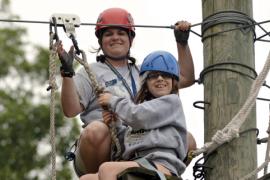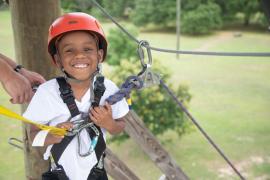Hero's Journey is a free-of-charge, wilderness-based summer camp program for youth living with serious illness. As a developmentally appropriate and challenging extension of the traditional camp program at The Hole in the Wall Gang Camp (Ashford, Connecticut), in 2013, Hero's Journey served sixty-seven adolescents ages sixteen through eighteen in groups of eleven to seventeen over five sessions of seven days each, including one sibling session. One nurse, five counselors, two program administrators, and two or three volunteers supervised each session of Hero's Journey. Participants were youth living with hemophilia, sickle cell, HIV/AIDS, cancer, metabolic disease, and other serious illnesses who were former campers of the traditional camp program.
The Hero's Journey program is grounded in Joseph Campbell's 1949 book, The Hero with a Thousand Faces (Carlson & Cook, 2007). Crafted as a rite of passage to help youth answer "What's next?" (see Figure 1), Hero's Journey engages participants through value-forming challenges and teaches skills such as positive communication, self-reliance, and decision making. One major program feature of Hero's Journey is training in wilderness first aid (e.g., scene and patient assessments), including a mock search and rescue. Other program activities include low-impact camping, map and compass work, teambuilding challenges, and personal reflection. One highlight is the Night Climb, in which participants climb a tower and zip line down at night, serving as a metaphor for their journeys through life and illness. Another highlight is the key ceremony, which summarizes participants' journeys and guides participants to "open the door" to what comes next with the keys of success.
While some might think that such wilderness-based challenging activities and experiences could be unsafe for youth living with serious illness, camps are places that are physically (Erceg, Garst, Powell, & Yard, 2009) and emotionally safe (Ehrenreich-May & Bilek, 2011). Camps can also provide youth with chronic illness a sense of camaraderie, belonging, and connectedness (e.g., Woods, Mayes, Bartley, Fedele, & Ryan, 2013). Understanding what camps do to create environments conducive to the development of youth outcomes is a focus of developmental systems theory (DST; Damon & Lerner, 2008; Lerner & Castellino, 2002). The Hero's Journey program theory contained key elements of DST's notion of "fit" between individuals and their environment. That is, activities and experiences were developmental-stage appropriate, interesting, engaging, provided support via interactions with caring adults and peers, and opportunities for building competence. A simpler way to put it is that the activities were fun!
The purpose of this study was to understand the outcomes of safety, camaraderie, and outdoor challenge and participants' perceptions of fun in the Hero's Journey program activities. The study questions were:
- Was there a difference in outcomes for youth who had more or less fun with the program activities?
- Did fun predict outcomes?
- What elements of the Hero's Journey program related to the outcomes of safety, camaraderie, and outdoor challenge?
Methods
Parent or caregiver consent to participate in the survey was obtained for thirty-eight of the sixty-seven Hero's Journey participants. Participants completed questionnaires on their last evening at camp using the iPad QuickTapSurvey app. Campers who had consent to participate used one iPad, and those without consent used another. Only results from the thirty-eight participants with consent are reported.
Campers answered closed- and open-ended questions. Closed-ended questions asked participants how much they agreed or disagreed with statements about safety, camaraderie, and outdoor challenge on a response format including one (strongly disagree), two (disagree), three (neither disagree nor agree), four (agree), and five (strongly agree) and are reported in Table 1. Closedended questions about perceptions of fun were measured on a response format including one (no fun), two (a little fun), three (some fun), and four (a lot of fun) for seventeen activities (e.g., journaling, wilderness first aid, milk crate stack, key ceremony, and night climb). Openended questions asked, "Do you have any comments and suggestions about the day and evening activities; what would you recommend we start doing, stop doing, and continue doing for these activities at Hero's Journey; what did you do at Hero's Journey that you didn't expect you could do; and please write about your favorite moment at Hero's Journey." Quantitative and qualitative data analyses involved descriptive statistics, reliability, t-tests, regression, and generation of themes across open-ended questions that related to the outcomes.
Results
Analyses of the quantitative data revealed that all scales were reliable, participants who had more fun reported significantly higher outcomes than participants who had less fun, and fun correlated well with and was a good predictor of outcomes. Analyses of the qualitative data from all thirty-eight participants for all four open-ended questions revealed five themes related to outdoor challenge (103 responses): accomplishment, learning new skills, dealing with outdoor life discomfort, using challenging activities to get to know others more deeply, and the key activities of mock rescue, tower, and key ceremony. Three themes related to safety (65 responses): self-discovery, physical challenges (especially through the tower activity), and helping others (especially through the mock rescue activity). Two themes related to camaraderie (45 responses): appreciation for peer connections and wanting even more peer connections. Qualitative data analysis conceptually linked outcomes to activities, which showed strong convergence between the qualitative and quantitative data. For example, one participant wrote, "I did not think that I would be able to speak out on my feelings as easily as I thought. The mood around the fire just made me want to." This statement contributed to the camaraderie theme of appreciation for peer connections.
Discussion and Recommendations
Hero's Journey answers the call of Sibthorp and Morgan (2011) to extend the accessibility and delivery of the benefits of adventure experiences to diverse youth populations by providing strong opportunities for feelings of safety, camaraderie, and outdoor challenge to campers living with serious and life-threatening illnesses. Findings from this study suggest that fun plays a central role in fostering these outcomes. Opportunities for fun are particularly important for young adults living with a serious or life-threatening illness who otherwise have limited prospects for these experiences in their everyday lives. This study contributes to the camp knowledge base by articulating connections between camp program activities and youth outcomes.
The mock rescue and tower were frequently mentioned in open-ended responses and were ranked as very fun program activities that appeared to be major drivers of youth outcomes. Additionally, the key ceremony provided an intensive self-reflection opportunity that further enhanced the outcomes of safety and camaraderie. Camp staff should continue these activities, consider how these activities contain essential program features that drive participants' outcomes, and integrate similar features (i.e., challenge by choice, emotional and physical safety, and connections with others) into other program activities. Outdoor living items had mixed responses reflecting a range of negative and positive attitudes, and camp staff should consider the comfort levels that participants bring to living in the outdoors and provide extra support to those who struggle with living in a yurt, bathing in a river, bugs, and cooking outdoors. Program leaders could model positive attitudes about outdoor living, intervene with participants having an unusually difficult time, and discuss and share videos of the wilderness site with participants prior to the program to familiarize participants with outdoor life.
Still, most participants reported they would not change anything about the experience and identified many important safety-, camaraderie-, and outdoor challenge–related outcomes. Three major recommendations emerged for camps wishing to engender similar outcomes. First, program staff should understand and harness the power of physically and emotionally safe social environments for adolescents living with serious illness to get to know each other more deeply and to share their experiences. Second, utilizing and reflecting on outdoor challenges can enhance feelings of camaraderie and safety through structured relationship-building activities. Third, camps should consider using the Hero's Journey model to intentionally program for participants' transformational experiences as youth build capacity, character, and community.
References
Carlson, K.P., & Cook, M. (2007). Challenge by choice: Adventure-based counseling for seriously ill adolescents. Child and Adolescent Psychiatric Clinics of North America, 16(4), 909-919. doi: 10.1016/j.chc.2007.05.002
Damon, W., & Lerner, R.M. (Eds.). (2008). Child and adolescent development: An advanced course. Hoboken, NJ: John Wiley and Sons.
Ehrenreich-May, J., & Bilek, E. (2011). Universal prevention of anxiety and depression in a recreational camp setting: An initial open trial. Child & Youth Care Forum, 40(6), 435-455. doi: 10.1007/s10566-011-9148-4
Erceg, L.E., Garst, B.A., Powell, G.M., & Yard, E.E. (2009). An injury and illness surveillance program for children and staff: Improving the safety of youth settings. Journal of Park & Recreation Administration, 27(4), 121-132.
Lerner, R.M., & Castellino, D.R. (2002). Contemporary developmental theory and adolescence: Developmental systems and applied developmental science. Journal of Adolescent Health, 31, 122-135. doi: 10.1016/ S1054-139X(02)00495-0
Sibthorp, J., & Morgan, C. (2011). Adventurebased programming: Exemplary youth development practice. New Directions for Youth Development, 2011(130), 105-119. doi: 10.1002/ yd.400
Woods, K., Mayes, S., Bartley, E., Fedele, D., & Ryan, J. (2013). An evaluation of psychosocial outcomes for children and adolescents attending a summer camp for youth with chronic illness. Children's Health Care, 42(1), 85-98. doi: 10.1080/02739615.2013.753822
Ann Gillard has worked, volunteered, and taught with youth-serving organizations and agencies, especially camps, for over eighteen years. Current research focuses on youth with chronic illness, program evaluation, and social justice. Contact the author at Ann.Gillard@holeinthewallgang.org.



